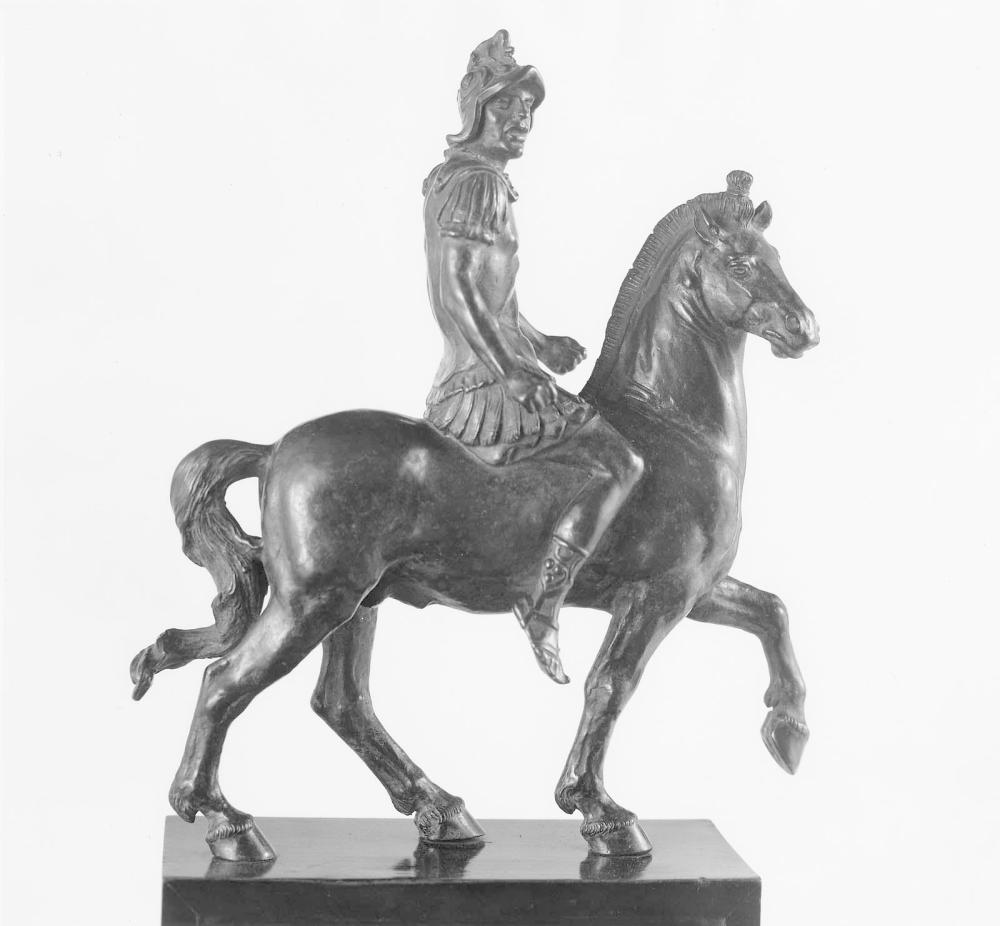Advanced Search 

Equestrian figure
After: Andrea Riccio [Briosco] (Italian, 1470–1532)
Italian (Padua?)
Renaissance
15th century
Object Place: Europe, Padua, Italy
Medium/Technique
Metal; bronze
Dimensions
Overall: 29.2 x 25.4cm (11 1/2 x 10in.)
Other (Part A): 24.1 x 14 x 11.4cm (9 1/2 x 5 1/2 x 4 1/2in.)
Other (Part A): 24.1 x 14 x 11.4cm (9 1/2 x 5 1/2 x 4 1/2in.)
Credit Line
John H. and Ernestine A. Payne Fund
Accession Number52.279
NOT ON VIEW
CollectionsEurope
ClassificationsSculpture
ProvenanceHeilbronner; sold by Heilbronner to Victor Hahn, Berlin; June 27, 1932, Victor Hahn sale, Ball and Graupe, Berlin, lot 160, sold for 10,050 M. Baron von Stumm (probably Ferdinand von Stumm, b. 1880), Schloss Rauischholzhausen, Nieheim, Holzhausen, Germany [see note 1]; by about March, 1938, with Hans W. Lange, Berlin; June 1938, sold through Hans Lange, Berlin, to Eugene L. Garbáty (b. 1880 - d. 1966), Schloss Alt-Döbern, Niederlausitz (Germany) [see note 2]; 1939, stored by Garbáty in Paris during his emigration; after 1943, recovered by Garbáty, East Norwalk, CT [see note 3]; 1952, sold by Garbáty to the MFA for $6000. (Accession Date: March 13, 1952)
NOTES:
[1] According to information in the MFA curatorial files, Garbáty acquired this sculpture from the collection of Baron von Stumm through Hans Lange, Berlin. In 1939, Lange would auction a large portion of the Stumm collection publicly; see "Gemälde, Möbel, Tapisserien aus dem Besitz Baron F. von Stumm, Schloss Holzhausen und aus anderem Besitz" (Hans W. Lange, Berlin, March 30, 1939). This sculpture is not included in that auction.
[2] In March 1938, Lange reported that Leo Planiscig attributed the work to Riccio, and Georg Swarzenski wrote to Garbáty on March 12, 1938, regarding the purchase. The sculpture thus seems to have been with Lange, and being at least considered for purchase by Garbáty, in March of 1938. Garbáty noted that Leo Planiscig attributed the work to Riccio "even earlier than when Eugene Garbáty acquired the piece (June 1938)."
[3] Eugene Garbáty fled Germany in 1938, after the family company (of which he was part owner), Garbáty Zigarettenfabrik, was Aryanized, or sold to non-Jewish owners. He traveled through France and entered the United States in 1939, eventually settling in East Norwalk, CT. Although Garbáty was able to bring much of his art collection with him, he did leave certain objects behind in Europe, including this sculpture. In a 1943 U.S. census form itemizing his property abroad, he attested that a bronze "Horseman on horse, made by Andrea Briosco, dit Riccio" measuring 28.5 cm., had been left with an acquaintance in Paris who had since emigrated to Cuba. (National Archives and Records Administration, College Park, MD: RG 265/450/69/17-/02-, Box 136, Foreign Funds Control Form TFR-500: Census of Property in Foreign Countries, Series A-1). Although exactly when and how Garbáty recovered the sculpture is not known, it was certainly in his possession again by 1952, when he offered it to the MFA.
NOTES:
[1] According to information in the MFA curatorial files, Garbáty acquired this sculpture from the collection of Baron von Stumm through Hans Lange, Berlin. In 1939, Lange would auction a large portion of the Stumm collection publicly; see "Gemälde, Möbel, Tapisserien aus dem Besitz Baron F. von Stumm, Schloss Holzhausen und aus anderem Besitz" (Hans W. Lange, Berlin, March 30, 1939). This sculpture is not included in that auction.
[2] In March 1938, Lange reported that Leo Planiscig attributed the work to Riccio, and Georg Swarzenski wrote to Garbáty on March 12, 1938, regarding the purchase. The sculpture thus seems to have been with Lange, and being at least considered for purchase by Garbáty, in March of 1938. Garbáty noted that Leo Planiscig attributed the work to Riccio "even earlier than when Eugene Garbáty acquired the piece (June 1938)."
[3] Eugene Garbáty fled Germany in 1938, after the family company (of which he was part owner), Garbáty Zigarettenfabrik, was Aryanized, or sold to non-Jewish owners. He traveled through France and entered the United States in 1939, eventually settling in East Norwalk, CT. Although Garbáty was able to bring much of his art collection with him, he did leave certain objects behind in Europe, including this sculpture. In a 1943 U.S. census form itemizing his property abroad, he attested that a bronze "Horseman on horse, made by Andrea Briosco, dit Riccio" measuring 28.5 cm., had been left with an acquaintance in Paris who had since emigrated to Cuba. (National Archives and Records Administration, College Park, MD: RG 265/450/69/17-/02-, Box 136, Foreign Funds Control Form TFR-500: Census of Property in Foreign Countries, Series A-1). Although exactly when and how Garbáty recovered the sculpture is not known, it was certainly in his possession again by 1952, when he offered it to the MFA.
Copyright
